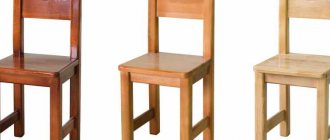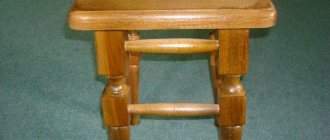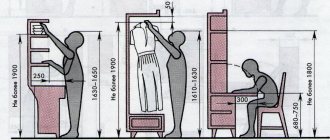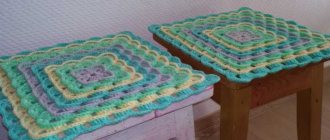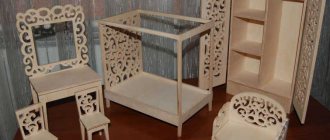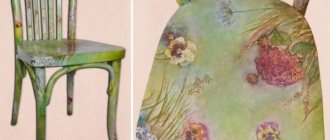Very often at home or in the country you can find an old, but very comfortable chair, which you would be sorry to throw away and cannot put in a visible place. In this article we will show you how you can easily repair a Viennese chair.
The old furniture is very good quality. With a little effort, the old chair will get a second life and will last for many more decades.
We will look at the restoration using the example of a Viennese chair with a back and soft seat, made of natural hardwood.
Let's briefly look at the main elements of the chair.
Product history
The technology for creating such chairs was invented by master Michael Thonet, who lived in Vienna in the 19th century. The products were created from beech wood, bent under the influence of steam. The furniture instantly gained popularity. The famous chair, which has survived to this day practically unchanged, bore the number 14.
Today this furniture is as popular as at the time of its creation.
Chair design
The design consists of two arches that are connected to the rear legs, and complemented by a round seat. The elements are connected with screws. The beauty of furniture is that it is very simple, but looks impressive.
Although the Viennese chair is already about 200 years old, it does not lose its charm and fits well into many interiors.
The advantage of the furniture is that it is incredibly durable, which means that after restoration it will last for many years.
Viennese style chairs are made only from natural wood.
Making a Viennese chair
Knowing how a Viennese chair is made, you can complete the job within one day. Previously, the curved back was made from beech wood rods, but now it can easily be replaced with iron rods or even plastic. Making a chair with your own hands is carried out in four stages:
Viennese chair details
- Making a seat. To do this, take a rounded wooden plate, to which foam rubber is applied according to size. You can cover it with any fabric or leather, the main thing is that the material is not too thin. The product is secured on the bottom side using a construction stapler.
- You'll have to tinker with the back a little longer. You need to know how to bend metal or plastic correctly so that it takes the desired shape and does not crack. The form is at your discretion.
- The legs are made of the same material as the back. You can make them straight, but it is better to create a slight bend, this will give more charm and lightness to the finished product.
- Assembling all parts into a single structure.
The Viennese chair with your own hands should be painted with some kind of paint at the end of the work. In accordance with the style, you need to choose light shades; they look more elegant and easily complement the interior of many rooms.
Design options
Manufacturers offer classic Viennese chairs made from bent wood, as well as modern metal models. They are made in the same configuration, but from more durable material. Such chairs are less likely to need repair and restoration.
The streamlined and smoothed design of these chairs with different color tones fits perfectly into the interior of the dining room, living room, nursery or kitchen.
Classic chairs are:
- without armrests with hard seats;
- without armrests with soft seats;
- with shortened armrests that are connected to the back;
- half-chairs with a wide back and long armrests.
Why Viennese chairs?
Many people wonder how to update Viennese chairs. To begin with, we should note their phenomenal strength, which is why it is easier to update them than to purchase a new one. Also, do not forget about convenience, because you can sit on such furniture for several hours and a person will not feel tired. Another advantage of this furniture is its original appearance. These chairs are perfect for the living room, kitchen and even bedrooms. Now it is possible to install them on the balcony near a light table.
Restored chair
Restored chair 2
Restored chair 3
Restored chair 4
Restored chair 5
Restored chair 6
Judging by the large number of advantages, making them will be much more convenient than buying them. Moreover, now it will not be easy to get such a durable and high-quality model at a fairly reasonable price. Therefore, you shouldn’t rush to send them to the landfill; by changing their appearance you can complement the interior of your apartment in an original way. Moreover, on the Internet there is a large amount of photo and video materials with step-by-step instructions that describe each action in detail.
How to restore a Viennese chair with your own hands
To put an old, high-quality chair in order, you don’t have to call a professional. All work can be done with your own hands. The restoration of the Viennese chair will consist of strengthening the structure, repairing cracks and decorative finishing. If the seat has upholstery and it is worn out, you will have to replace the fabric and padding.
First of all, before you begin restoration, inspect the product itself to understand all the weak points.
How to update a chair or armchair
First of all, it is necessary to recall that the method of restoration depends on the exact nature of the damage. If we try to identify the main damage, we can identify the most common types of damage:
- A broken leg, problems with the back, seat or other wooden part.
- The upholstery is showing wear.
- The paintwork on the wooden surface has worn out (especially during the restoration of Viennese chairs).
So, the method of restoring the chair will depend on which part is broken or worn out. So, the restoration and repair scheme should be chosen depending on the places (or places) in which problems exist.
Often it is enough to simply connect the separated parts, restoring one of the connecting parts that may have deteriorated over time. We are talking about groove and tenon. Wear or expansion of one of them leads to the fact that the chair gradually becomes unstable and begins to wobble on its legs. Repair, as a rule, consists of almost complete disassembly of the structure with extension of the tenon. To solve this problem you will have to, as they say, try.
On the other hand, if you need to restore a wooden chair in which the old paintwork has deteriorated, it can be done much easier. If the varnish is cracked, you just need to remove it and sand the surface with fine-grain sandpaper. And then apply another coat of paint. Or varnish, if this type of coating is provided for you. In any case, paint or varnish is your choice.
Reupholstering old chairs is also a fairly simple matter. To do this, you only need to replace the old worn or torn fabric with a new one. Let's take a closer look at the main stages of restoring chairs at home.
Selection of tools
To disassemble and reassemble the chair you will need a screwdriver and a screwdriver. You can leave the old fasteners if their threads are not damaged, or you can replace them with new ones.
Tools and materials that you may need when carrying out restoration work on chairs.
To correct the configuration and finishing you will need:
- hammer;
- clamps;
- wooden mallet;
- sandpaper;
- solvent.
To change the upholstery, you will need a furniture stapler and staples.
Viennese
To repair Viennese chairs yourself, you first need to assess their general condition. The amount of damage may depend on operating conditions.
The most important damage that can be assessed at home is instability. This occurs due to weakening of the tenon joints. To bring the product back to normal condition, it is necessary to increase the size of the tenon, install seals on the drawers and replace the power bars. After this, the paintwork is replaced and the seat is restored.
To restore an outdated structure, you need to prepare basic materials and tools. To work, you need to get a hammer, a furniture stapler, a self-tapping screw, paints and varnishes, solvent, brushes, glue, scissors, cloth and sandpaper.
The renewal process begins with cleaning all surfaces of the product from dirt and dust. After this, the analysis of the chair begins. First, remove the seat and backrest, which are usually held on with screws. Then step by step the remaining parts are removed
It is important to check the strength of all connections. If any attachment point does not hold well, then it is not worth disassembling it
Disassembled elements must be replaced immediately to avoid errors during the assembly process. All parts are sanded with sandpaper to thoroughly remove old varnish. This is necessary so that the furniture can be repainted so that the new layer fits perfectly on the chair.
Next, be sure to inspect the places where the elements are glued. The top of the legs, which are attached to the grooves, must be wrapped in several layers of bandage, covering each layer with glue. If the leg wobbles very much, then a hole is made in the end, into which a small wedge is then driven. This will increase the width of the end, and the leg will hold firmly in the groove.
For drawstring structures with a weakened seam, you need to make a hole on the inside and use a syringe to inject an adhesive into it. You can also resort to matches coated in glue and insert them into the socket when assembling the chair. In this case, the ends must be adjusted with great precision so that no gaps form between them and the drawers.
Assembly of the structure begins with complete gluing of all tenon joints. Excess glue should be removed with a napkin. The product dries for about a day, and for maximum fixation you need to place some heavy object on the seat.
To update the seat, you need to get rid of the worn upholstery and eliminate any surface imperfections. If you need to change the foam rubber, then you need to draw markings on the new foam rubber sheet and cut out the part. The fabric with which the seat will be upholstered must be larger than the resulting seat. It is placed closely on the surface and secured with paper clips on the back side.
The chair itself can be decorated in Provence style. To do this, all wooden parts are painted and, after drying, processed with a sanding machine.
Completing of the work
During the inspection process, possible defects are identified.
The first stage of restoring a Viennese chair with your own hands is preparation. The product must be thoroughly cleaned of dust and dirt. You can briefly immerse the chair in water and wash it with soapy water. But it’s better not to overdo it: wood absorbs moisture and swells. After this, the furniture is dried naturally. You can place the chair on the balcony, but not in direct sunlight.
It is better not to disassemble connections in which the parts are held tightly.
Already at this stage the varnish will begin to partially peel off.
The chair must then be inspected to assess the scale of the work.
Important: before washing a chair with upholstery, it must be removed so that moisture does not linger in the fabric and fillings and harm the wood.
It is better to mark all disassembled parts so that there are no problems during assembly later.
Disassembly of the structure
The simplest thing is to unscrew the bolts and remove all possible elements from the base. This is necessary to simplify the process of grinding and repairing damaged parts.
First, remove the seat and backrest. In old chairs they are mostly attached with screws.
Fasteners should be placed in a separate bag or organizer. Deformed or rusty elements should be replaced with identical ones.
Options for fastening parts and methods of disassembly:
- the legs are attached according to the tongue-and-groove principle - they must be carefully loosened in order to be removed from the base, the back and seat are separated in the same way;
- if the chair is assembled with screws, they must be removed using lubricating oil so that they slide out of the grooves faster;
- glued furniture can be preheated with a hair dryer at the seams or the joints can be treated with a rag dipped in hot water, so the glue will become soft and the parts can be separated without much effort.
It may happen that the leg wobbles a lot in the socket, then you need to cut a slot at the end and drive a small wedge into it.
Sanding parts
The main part of the varnish and paint can be removed with a solvent. Or go straight to mechanical grinding. You will need a jigsaw or sandpaper of varying degrees of grit. First use with the coarsest grain, and the final cleaning is done with fine-grained paper.
When the parts are completely free of paint and smooth, sanding is complete.
Sanding is needed to remove as much old varnish as possible.
Repair of chair mounts
An important stage in repairing a Viennese chair with your own hands is the restoration of the fastenings.
How to do it:
- The ends of parts that have worn out need to be sawed a few cm deep.
- Drive wedges between them so that the seating part sits tightly in its original place.
If there is a need to strengthen the drawer, you need to cut out several blocks in the shape of a trapezoid.
One side is attached to the leg, the other to the drawer. If antique fragile furniture is being restored, a thin hole is cut out in the connecting seam. Wood glue is injected into it. Severe tenon wear can be corrected by a wedge made from wood chips. It is lubricated with glue and inserted into the hole along with the part.
If necessary, for better fixation of the parts to be glued, they can be pressed together with clamps or rubber bands. Rubber bands from expanders are ideally suited for these purposes.
Assembly
The prepared and cleaned parts are connected to each other in the same way (with glue, screws or tongue-and-groove technology). If the fastening points are worn out, you can additionally apply wood glue.
Decoration features
There are several ways to refresh the appearance of your chair:
- treat with stain and varnish;
- treat with wood putty, prime and paint.
As decoration, you can use both the upholstery itself, choosing a fabric of interesting colors like a tapestry, and other parts of the furniture, making them carved and figured.
For finishing, transparent or tinted varnish or acrylic paint of any shade are suitable. To give the chair a classic look, you need to leave the wood texture visible and simply varnish it. Bright chairs are suitable for kitsch or modern interiors.
The seat or back can be decorated using decoupage technique:
- Take decoupage napkins or newspaper clippings.
- Dilute PVA with water (1:1).
- Immerse the image in the solution and soak it slightly.
- Transfer the design with a brush to the surface.
- Allow to dry and seal with 2-3 layers of varnish.
The wooden surface of the supporting structure and the back are laminated, that is, covered with durable varnish in several layers.
The painting will look beautiful and unusual.
Soft seat on the chair
To repair the soft upholstery on the seat, you need to remove the old one in such a way that the pattern can be removed from it. It is transferred to new fabric, allowances of several cm (5-10) are made.
A leaky seat is updated by replacing the base with slats or the upholstery is completely restored.
It is very important to choose a comfortable filler. You can make the layer a little thicker to make sitting on the chair more comfortable. Regular foam rubber is suitable for this. From it you need to cut a part in the shape of the seat, a couple of cm smaller than the part itself.
The filler is attached to the seat with glue so that it does not move out.
Important! The upholstery is placed in the center, the edges should be free so that the upholstery can be folded under them.
Complete replacement and restoration of upholstery.
For greater convenience, you can put a layer of synthetic padding on top of the foam rubber or use polystyrene foam. This is a more modern material that holds its shape well and does not sag over time.
The last stage is to stretch the upholstery over the seat and fasten it with a furniture stapler.
It is important that the color of the material is in harmony with the legs of the chair. You can see successful options in the color correlation table. Elastic and durable furniture fabrics are chosen for upholstery: chenille, matting, tapestry.
You don't have to place the fabric on the outer sides of the seat. Then the upholstery is folded inward around the perimeter. The seat frame will be visible.
Master class on restoring a chair with your own hands (step-by-step instructions with photos)
Are the tools ready? Chair and are you ready? Forward!
1) Let's see how the chair was fastened together. First of all, you need to disassemble everything that “moves”:
Where there are screws, carefully remove them, carefully remove the wooden dowels on the legs with a drill (just drill them out), very carefully pull out the nails (if the chair was knocked together).
2) We number all the details that exist. Necessarily. The numbering goes from the legs up. Accordingly, you should have at least 10 parts, depending on how the chair was made:
- legs,
- Crossbars for legs,
- Seat,
- Two slats for the back,
- The back itself.
We carefully inspect all parts for cracks (you can’t see everything at once, don’t worry). If you doubt your memory, take a regular photo when restoring furniture. It helps, honestly.
3) Glue all the cracked parts together. Excess glue will be removed after sanding.
To ensure that the parts stick together well and are guaranteed to last longer, we compress them with clamps
4) We pay special attention to the repair of the chair seat:
- We simply trace the old plywood seat onto a new sheet of plywood, carefully cut it out with a jigsaw,
- Glue the foam rubber (also cut to the shape of the seat) onto the new plywood seat as carefully as possible.
- Be sure to secure the foam rubber along the edges with a furniture stapler and leave it to dry for a day.
If you want to make the seat softer, then you attach each new layer of foam rubber along the edges, without gluing it.
We throw out the old seat.
4) After gluing the parts, carefully sand them with a grinding machine and sandpaper (round and small parts cannot be passed through with a grinding machine). Remove any remaining fine dust with a slightly damp cloth. We inspect everything again for cracks. Here is a video on restoring an old chair from one home craftsman, you might be interested:
5) Finishing the seat
When restoring an old chair, this is no less important than the repair process. On the widest part of the seat we fasten the tapestry with a stapler, pull it forward very tightly, bend the edges under the seat
There should be at least 5 cm of fabric along each edge. We fasten the fabric with a furniture stapler at a distance of 1-2 cm. We repeat the procedure on all sides of the seat.
The result is a kind of drum, inside of which there is not emptiness, but foam rubber.
Continuation of the video from a home craftsman, do-it-yourself seat restoration:
6) We cover all the parts with stain, and after a day we paint them with 3-4 layers of varnish so that the chair does not become covered with cracks the first time a guest sits on it.
7) Assembling the chair. When gluing the parts, we do not spare the glue; we very carefully wipe off the excess and remove it with a slightly damp cloth.
We reinforce the connecting parts of the seat and legs, crossbars and backrest with metal corners mounted on screws!
Nails do not have the desired “longevity” effect.
We cover it again with a layer of varnish to hide the unevenness and that’s it - your chair is restored and ready for use again!
End of the video on chair restoration from a home craftsman:
